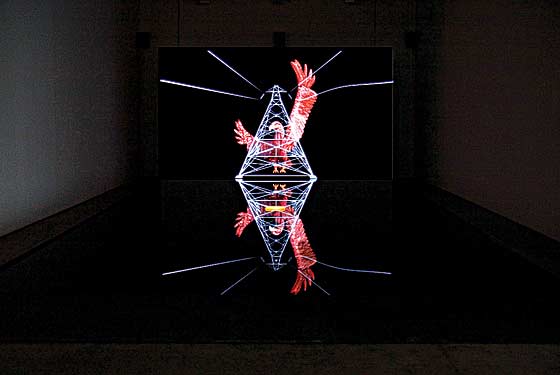

1. Anthony McCall
Sean Kelly, 528 W. 29th St; through March 17
In his first New York gallery show in decades, McCall returns to the abstract cinema he developed in the seventies: film-as-sculpture, experienced by staring away from the screen into a slowly moving projection beam. Stunning from any angle, these works have been compared to Plato’s cave. Exercise caution when leaving the gallery: Watching the light shift and suddenly enclose you in a misty cone might make you think, for a moment, that you have the power to walk through walls.
2. Michael Rakowitz
Lombard-Freid Projects, 531 W. 26th St.; through February 17
Fleshing out Rummy’s concise response (“Stuff happens”) to the looting of the Iraqi museum, Rakowitz has re-created missing artifacts with papier-mâché made from Mideastern newspapers and packaging. It’s a powerful combination of connoisseurship and conscience, one that shifts our focus, if only briefly, from car bombs to cultural casualties.
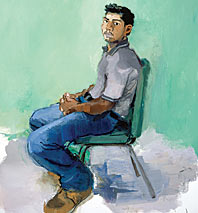
3. John Sonsini
Cheim & Read, 547 W. 25th St.; through February 10
Picking up illegal immigrants at the Home Depot and other gathering places near Los Angeles, the figurative painter John Sonsini paid them an hourly wage to pose for a series of studio portraits. They’re empathetic, but in simplistic, how-thoughtful-I-am terms: Look, poor people. It’s telling, in fact, that the former scenic artist’s breezy, uniform brushwork fails to distinguish hands from backpacks, faces from work boots. Single portraits, like Fernando (2006), work best; grouping the men seems to reinforce their social invisibility.
4. Gary Hill
Gladstone Gallery, 515 W. 24th St.; through February 10
By accident or design, the digitally animated eagle at the center of Gary Hill’s new installation is a wimpier version of the squawking bird that opens The Colbert Report. Here, the veteran sound-and-image artist’s political symbols of the most obvious kind (gold bullion, a broadcast tower) upstage an unsettling soundtrack of cracking whips. Guilt, an installation of gold coins printed with torture scenes and viewed through telescopes, combines a bad pun with a weary metaphor. Turning the abuses of Abu Ghraib and Guantánamo into genuinely affecting work is more difficult than it looks; Thomas Hirschhorn and Fernando Botero are among the few who have pulled it off. And in art, unlike TV satire, the blowhard act wears thin fast.
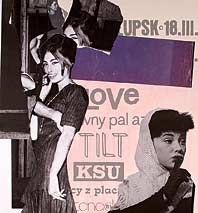
5. Paulina Olowska
Metro Pictures, 519 W. 24th St.; through February 10
Cold War nostalgia meets Polish punk: Many of the images in these colorful collages come from the old U.S.S.R. magazine Ameryka and its U.S. counterpart Soviet Life, published via a cultural-exchange program (the Americans wear bikinis and carry surfboards; the Soviets dress in ushankas and practice ballet). These relatively tame images get a jolt from scraps of torn posters from the Polish underground music scene. Spend your time upstairs with the smaller collages, which are more persuasively nostalgic than the large-scale works’ giant mash-ups of competing propaganda.
6. Justin Lieberman
Zach Feuer, 530 W. 24th St.; through February 24
This gallery-as-ad-agency show opens with a disclaimer: I AM A MANIPULATIVE CAREERIST SELLOUT. It’s a world-weary statement that prompts an equally fatigued response: Who isn’t, in this market? In a series of one-line-joke lightboxes, Lieberman rolls his eyes at ad campaigns (one uses the cover of Jonathan Safran Foer’s Everything Is Illuminated to hawk Ziploc bags: “Everything Is Laminated”). They’re fun, but the sculptures made from scrap wood, particularly the conference table and chairs in the back room, show more elbow grease and ambition.
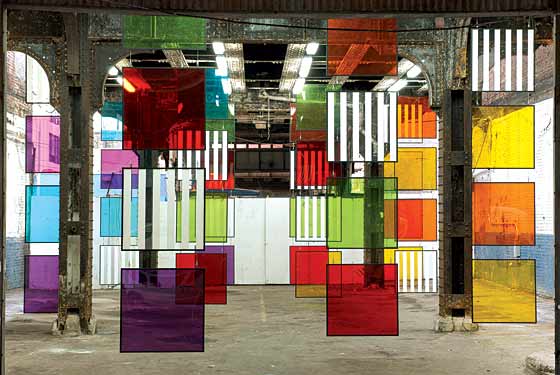
7. Daniel Buren
Bortolami Dayan, 510 W. 25th St.; through February 15
Buren’s painted stripes have lost their subversive sting in recent years (the Guggenheim, which removed one of his giant canvases from a 1971 exhibition, invited him to take over the rotunda in 2005). The 1966 work in the main gallery looks almost quaint—but the new outdoor installation, hinged squares of Plexiglas suspended from the underside of the High Line in an adjacent lot, inspires thoughts about the future of everyone’s favorite urban relic.
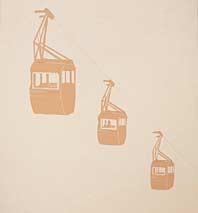
8. Veron Urdarianu
Mitchell-Innes & Nash, 534 W. 26th St.; through February 17
Working in a milky palette popularized by Luc Tuymans, Urdarianu layers paint over cardboard to create flattened shapes with crisp edges. As in Tuymans, the landscapes and interiors have a dour, suspenseful mood. A line of tram cars is labeled HYPNOTIZING MACHINE; office seating becomes a VICTIM CHAIR. The mystery is spoiled, however, by the overprecious architectural models scattered on the floor like abandoned dollhouses.